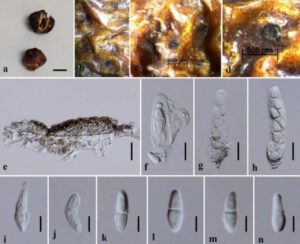Pseudostomiopeltis phyllanthi (Jayasiri, E.B.G. Jones & K.D. Hyde) Phookamsak & Hongsanan, in Hongsanan, Phookamsak, Bhat, Wanasinghe, Promputtha, Suwannarach, Sandamali, Lumyong, Xu & Xie, Frontiers in Cellular and Infection Microbiology 13(no. 1252387): 9 (2023)
Index Fungorum number: IF 900639; MycoBank number: MB 900639; Facesoffungi number: FoF 15865.
≡ Stomiopeltis phyllanthi Jayasiri, E.B.G. Jones and K.D. Hyde, in Jayasiri, Hyde, Jones, McKenzie, Jeewon, Phillips, Bhat, Wanasinghe, Liu, Lu, Kang, Xu and Karunarathna, Mycosphere 10(1): 131 (2019)
Etymology – Referring to the host genus on which the fungus was collected, Phyllanthus (Phyllanthaceae).
Saprobic on Phyllanthus emblica fruits. Sexual morph: Thyriothecia 19–35 μm high × 67–84 μm diam. (x̅= 23 × 74 μm; n = 20), solitary, gregarious, superficial, rounded, easily removed from the host surface, black; upper wall comprising a thin layer of neatly arranged dark cells of textura angularis. Hamathecium lacking pseudoparaphyses. Asci 44–49 × 7–9 μm (x̅= 45 × 8 μm; n = 20), 4- spored, bitunicate, fissitunicate, oblong to subglobose, with a minute pedicel, arranged vertically, apical region of asci usually with a thick opaque region, ocular chamber not observed. Ascospores 15–17 × 4–5 μm (x̅ = 16 × 4.5 μm; n = 20), uniseriate, hyaline, obovoid to ellipsoid, 1-septate, strongly constricted at the septum, equal length cells, but upper cell slightly broader, asymmetric. Asexual morph: Undetermined.
Material examined – Thailand, Chiang Rai, Mae Fah Luang University, on decaying fruit pericarp of Phyllanthus emblica (Phyllanthaceae), 20 March 2017, D. Thennakon, C-241 (MFLU 18–2115, holotype; KUN-HKAS 102418, isotype).
GenBank Accession Numbers – SSU: MK347842, ITS: MK347734, LSU: MK347951
Notes – Pseudostomiopeltis phyllanthi was first introduced as Stomiopeltis phyllanthi by Jayasiri et al. (2019) which was found as a saprobe on the fruits of Phyllanthus emblica. The species formed a sexual morph and is characterized by black, superficial, rounded thyriothecia, with the upper wall neatly lined by dark cells of textura angularis, lacking pseudoparaphyses, with 4-spored, fissitunicate, oblong to subglobose asci, and hyaline, obovoid to ellipsoid, 1-septate ascospores (Jayasiri et al., 2019). The present phylogenetic analyses of a concatenated ITS and LSU sequence dataset demonstrated that the species formed a separate branch and is basal to the clade Pseudostomiopeltis with significant support (90% ML, 0.98 PP). Therefore, we transferred S. phyllanthi to Pseudostomiopeltis as Ps. phyllanthi comb. nov.

Figure 1 – Pseudostomiopeltis phyllanthi (MFLU 18–2115, holotype). a Phyllanthus emblica seeds. b–d View of thyriothecia on host surface. e Section through thyriothecium. f–h Asci. i–n Ascospores. Scale bars: a = 1 cm, e = 20 μm, f–h = 10 μm, i–n = 5 μm.
